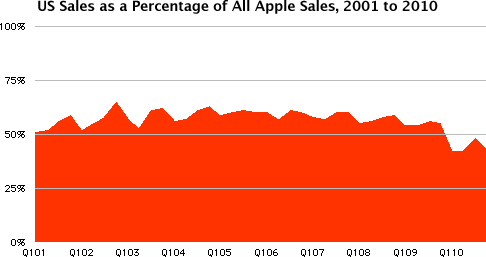Apple has been growing at a rapid pace for the last few years (see
Apple's Decade of Explosive
Growth: 2001 to 2010 for details). For most of that time, the
percentage of revenue from international sales has hovered around 40%.
Sales in the United States were still the largest sector for Apple.
That changed in 2010. For all four quarters of 2010, international
sales contributed between 52% and 58%, surpassing the domestic market.
This is effectively a role reversal for these two sectors.
Sales in the US are still important, just not as important as a year
ago.
What happened? The answer is a combination of
the expansion of Apple Stores overseas and the
first-time availability of the iPhone in many countries around the
globe. More than half of the new retail locations in 2010 were outside
the US. New stores were opened in London, Paris, Shanghai, etc. The
iPhone 4 is now sold in 22 countries.

Apple has the perfect demand channel waiting. Whenever it can't sell
more to US consumers, Apple simply offloads its surplus to country
after country until it's gone.
Estimating demand has always been difficult for Apple. Now they can
safely over estimate slightly and use the rest of the world to absorb
the difference. The main problem is getting suppliers to make enough
units.
Apple's strategy to make the iPhone a global phone has paid off. The
iPad is also a perfect product for the global market. Built to one
standard with a little variation for the charging adapter, Apple has
perfect global mass market appeal. Translating the iOS into a different
language is probably the most expensive part in moving to a new
market.
As an American, I find it a little discouraging to see the drop in
importance, but I can't fault Apple for a well planned and executed
strategy. 



